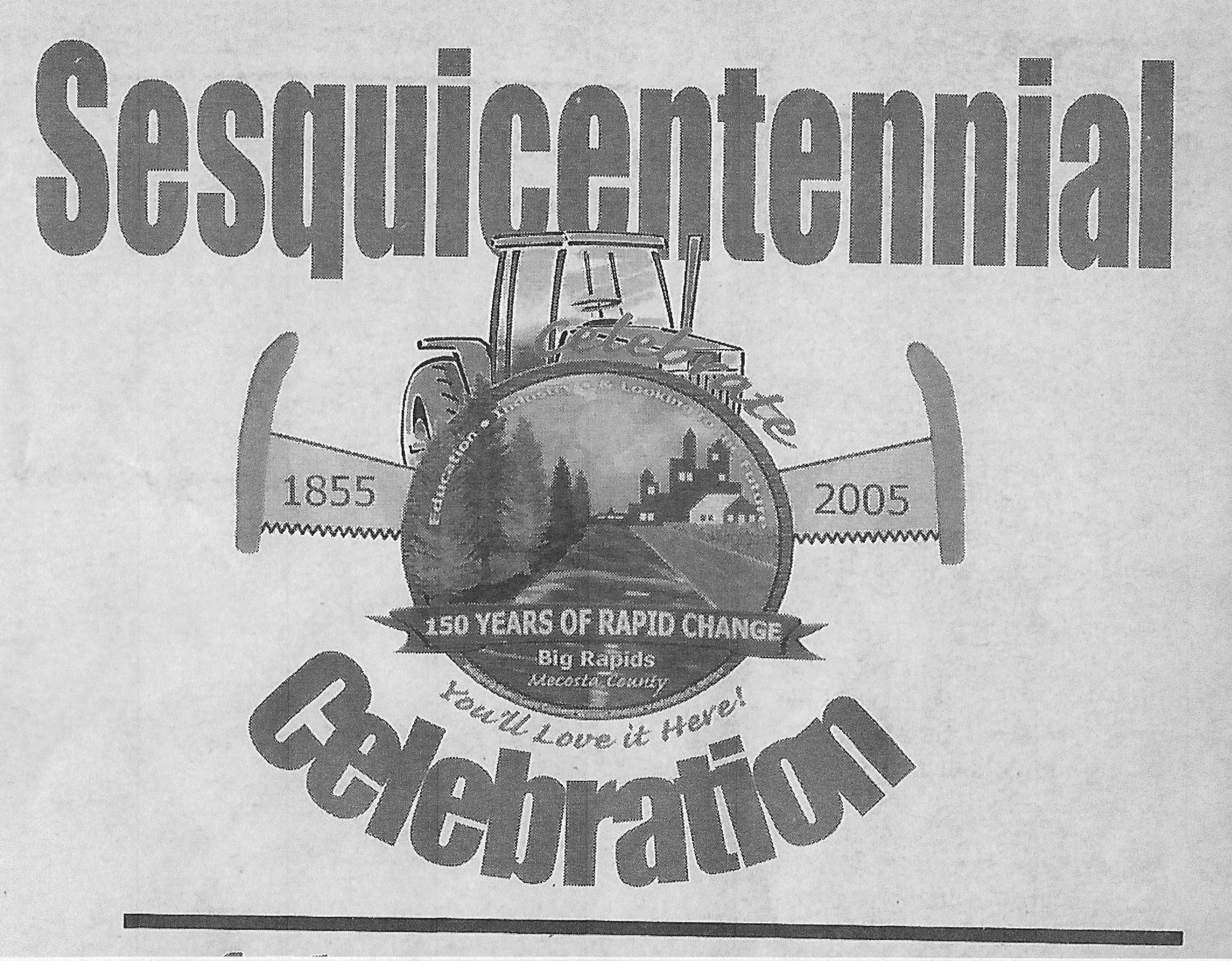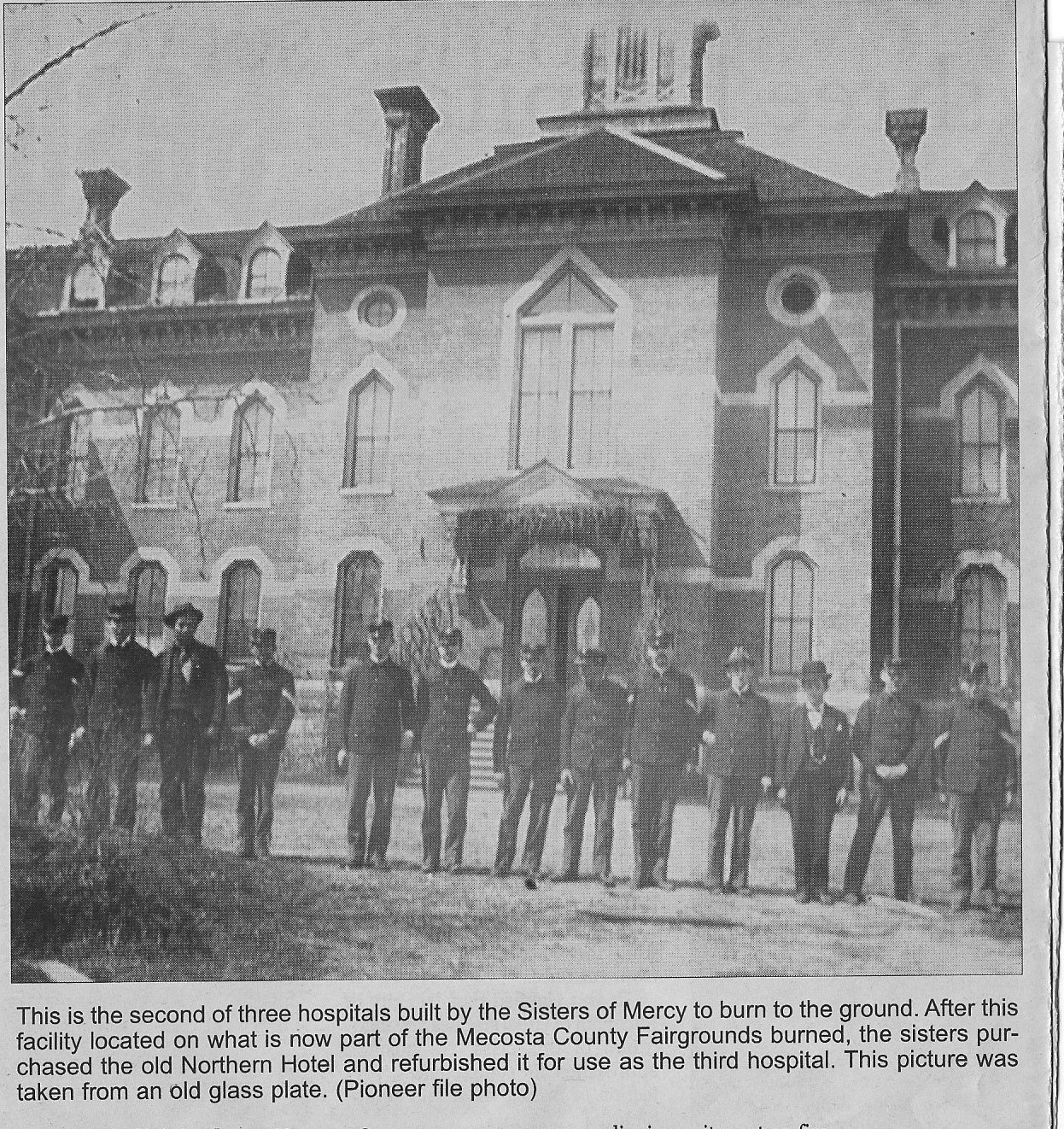
Part VII - Health Care, a supplement to the Big Rapids Pioneer Newspaper. Used with permission.
FIRE CLAIMED THREE HOSPITALS
SISTERS OF MERCY RETURN TO GR AFTER FLAMES CLAIM THIRD FACILITY
By Mary K. Hively - Special to the Pioneer



In 1879, Mercy Hospital, the first hospital in Big Rapids (possibly named St. Joseph's Hospital as noted on an old map on the wall of the Mecosta County Historical Museum) was built on 40 acres of land on the north side of Pere Marquette, between Farnsworth and Sheridan Streets, which is now the Mecosta County Fairgrounds. The facility cost $7,000.
At the time of its construction, Big Rapids was a thriving center for the lumbering industry, but lacked faciities to care for the sick and injured. Although there was a hospital in Grand Rapids, no hospital existed on the east side of the state between Detroit and Sault Ste. Marie.
To build a medical facility was declared "an urgent necessaity" by Father Herbstrit, a Catholic priest who persuaded the Sisters of Mercy to come and build Big Rapids a hospital.
Mother Mary Joseph Lynch, plus nine fellow Sisters of Mercy out of Grand Rapids, "volunteered for the new frontier in the service of Christ." Their mission was to build a hospital.
The Sisters of Mercy solicited funds from the cities of Big Rapids, Grand Rapids, and the whole of Western Michigan. A wood structure with a 150 foot front and wings each 40 feet deep was erected.
Mother Mary Joseph Lynch said, "The needs of this class of patients (lumbermen peculiarly libel to injury and disease) would be best served by a system of large wards, where a number of patients could be watched and cared for by comparitively few nurses." Large L-shaped rooms/wards were therefore constructed and insulated with sawdust.
Mother Mary Lynch made no distinction regarding creed or country of origin in the treatment of her patients, who were mostly males. "All will be welcome and will receive equal care ... for a small sum of a $5 certificate," which entitled the patient to the benefits of the hospital in case of sickness or accident.
At midnight, December 1882, a fire began in the Sisters of Mercy chapel. The hospital, being a wooden struture, was completey destroyed by the blaze. A wakeful patient sounded the alarm and no lives were lost.
The house of Captain and Mrs. Bliss was offered to the Sisters of Mercy for the care of the sick; effectively a temporary, 15 bed, two ward facility was established just west of St. Mary's Church.
In 1883 a second hospital, a htree floor brick, veneer structure was built by the Sisters of Mercy, facing east and located at the end of Williams Street. The new facility cost $24,ooo. The citizens of Big Rapids pledged $5,000. Money also came from Manistee, Muskegon, and lumbering firms of Cadillac.
In 1906 a four-story addition to Mercy Hospital was constructed in response for private rooms to accommodate femal patients, as well as lumbermen. One large 16 bed ward and 14 private rooms were said to be "nicely located away from the noise and bustle of the front entrance."
It was claimed that "No City in Michigan of equal size has any institution of this class . No hospital approached its completeness, perfection of management and equipment.
The hispital was equipped with three baths, four toilets, two rooms for night nurses, steam-heat, gas and electric lighting, an electric bell system and one telephone.
This newly built modern medical facility had mineral water, healing baths and x-ray equipment. The operating room, etherizing and sterilizing rooms, and doctor's dressing room were made to the specifications of doctor's W.T. Dodge and L.S. Griswold.
Four prominent women in the community solicited $500 for an ambulance, which initiated the area's first ambulance service.
"The citizens of modest incomes were now readily served, as opposed to the past when just the wealthy could afford house calls," said William Nisbitt, a newsman and historian of that era.
Then in April 1908 fire destroyed the second Marcy Hospital . An electrical fire was thought to have begun in the cupola and soon spread to the roof and adjoining wings. The volunteer fire deprtment responded quickly, but found that could not throw a stream of water far enough (insufficient pressure) to reach the flames. The great cross on the cupola crashed to the ground in flames. All 50 patients were removed unharmed.
The estimated worth of the 2nd Mercy Hospital and all its contents was $100,000.
Although the brick structure was lost, most of the equipment and records were saved by volunteers and hiosoital staff. The progress of health care was brought to a halt for one month, when in May 1908 health care was moved to the Northern Hotel.
NURSING SCHOOL IN 2ND MERCY HOSPITAL
In 1901 the first nusring class was graduated from a two-year program at the Mercy Hospital Nurse Training School. The teachers were five local doctors and one professor from Ferris Institute. (Dr. W.T. Dodge, L.S. Griswold, W.J. O'Hara. A.A. Spoor, and George H. Lynch.)
Nursing students were subject to very rigorous programs including classes in the diet kitchen and surgical dressing room, bed making, disinfecting clothes, and the cleaning and preparing of an ideal sick room. In addition oif ten hours per week in the classroom studying chemistry and anatomy, they attended two drills a week on "reading well."
Mercy Hospital Training School was held in high acclaim, citing one student selected to be charge nurse of a gynecology department at the University of Michigan upon her graduation.
In 1906 the educational standards were raised, and the curriculum was lengthened to a three year program.
In 1970 a nurses training program was initiated in which Mecosta County General Hospital cooperates with Ferris State University.
Rather than buuikd a third time, the discouraged but not beaten Sisters of Mercy bought the Northern Hotel which was located on the north side of Maple between State Street and Michigan Avenue, where the old Gary Trimarco delearship is now located.
The lumber boom of the late 1800s was now in decline; businesses of all kinds were at a standstill. The times were condusive for the Sister of Mercy to strike a business deal with the owner of the Northern Hotel.
With the $30,000 fire insurance claim, the nuns ourchased the 27 year-old Northern Hotel, which was no longer needed to hiouse the lumbermen wnd ther families.
''In a circular written by the Sisters of Mercy, funds fir the renivation of the Northern Hotek were solicited thriough the advertisement if a "modern bathing department" to be installed in this their third hospital, which was to be named Mercy Hospital Sanitarium.

The modern bathing department would be equipped with tub, shower, Turkish and vapor baths. The water from the famous Yo-Landa Mineral Springs would be used in the tub bath when indicated. "This water has demonstrated its value to chronic affections, as it posses laxitive properties similar in the imported Hunyadi Water. The baths will be given under the direction of skillful physicians and competent nurses wll be in attendance.
The Sisters of Mercy went on to describe the Mercy Hospital Sanitarium as "a well equipped sanitarium in the treatment of chronic nervous diseases.
And too, the hospital had to adapt itself to new requirements: Instead of being divided into large wards for the woodsmen, it was formed into spacious rooms for private patients.
Then in December of 1918 Mercy Hisopital Sanitarium/The Northern Hotel was destroyed by fire. It is said a new lot of ether had been brought into the hospital basement only a short time before the fire broke out.
"Three lives lost, two missing, Three injured" read the headlines of the Pioneer.
Flames were seen shooting from the windows, trapping persons on the second and third floor, for there were no fire escapes.
The Norther Hotel/Mercy Hospital had a large impressive lobby. At one end was a huge double wide stairway, which quickly becam engulfed in flame. Heavy plumes of smoke billowed up to the second floor entrapping patients and personnel.
Persons were seen jumping from the third story windows, only to be hung up by the telephone wires. One young man was seen clinging by his fingers to a window ledge before being rescued by the ladder and fire wagon.
The wind carried cinders from the burning hospital, nearly catching the block of buildings located to the east of the fire.
With the destruction of the Northern Hotel, the third of three hospitals built by Sister Mary Joesph Lynch, the Sisters of Mercy moved their Mother House back to Grand Rapids.
Return to Mecosta sesquicentennial Page
Return to Home Page





